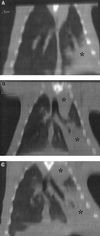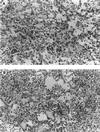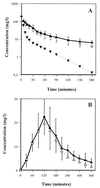Development of a new experimental model of penicillin-resistant Streptococcus pneumoniae pneumonia and amoxicillin treatment by reproducing human pharmacokinetics
- PMID: 10508029
- PMCID: PMC89505
- DOI: 10.1128/AAC.43.10.2484
Development of a new experimental model of penicillin-resistant Streptococcus pneumoniae pneumonia and amoxicillin treatment by reproducing human pharmacokinetics
Abstract
The increase of penicillin-resistant Streptococcus pneumoniae (PRSP) pneumonia results in a greater risk of antibiotic treatment failure. In vitro data are not sufficient predictors of clinical efficacy, and animal models may be insufficiently contributive, since they often use immunocompromised animals and do not always respect the human pharmacokinetics of antibiotics. We developed an experimental PRSP pneumonia model in immunocompetent rabbits, by using intrabronchial instillation of PRSP (MIC = 4 mg/liter), without any adjuvant. This reproducible model was used to assess amoxicillin efficacy by reproducing human serum pharmacokinetics following 1-g oral or intravenous administrations of amoxicillin every 8 h. Evaluation was performed by using clinical, CT scan, macroscopic, histopathologic, and microbiological criteria. Experimental pneumonia in untreated rabbits was similar to untreated severe human bacteremic untreated pneumonia; in both rabbits and humans, (i) cumulative survival was close to 50%, (ii) red or gray lung congestion and pleuritis were observed, and (iii) lung and spleen concentrations reached 5 and 4 log(10) CFU/g. A 48-h treatment resulted in a significant bacterial clearance in the lungs (1.53 versus 5.07 log(10) CFU/ml, P < 0.001) and spleen (1.00 versus 4.40 log(10) CFU/ml, P < 10(-6)) and a significant decrease in mortality (0% versus 50%, P = 0.02) in treated versus untreated rabbits. No difference was observed on macroscopic and histopathologic lesions between treated and untreated rabbits (P = 0.36 and 0.78, respectively). Similar results were obtained by using a fully penicillin-susceptible S. pneumoniae strain (MIC = 0.01 mg/liter). Our findings suggest that (i) this new model can be contributive in the evaluation of antibacterial agents and (ii) 1 g of amoxicillin three times a day may be sufficient to treat PRSP pneumonia in immunocompetent humans.
Figures


 , macroscopic score;
, macroscopic score;  , histopathologic score; ---○---, lung pneumococcal concentrations; ---●---, spleen pneumococcal concentrations.
, histopathologic score; ---○---, lung pneumococcal concentrations; ---●---, spleen pneumococcal concentrations.



 , macroscopic score;
, macroscopic score;  , histopathologic score; ---○---, lung pneumococcal concentrations; ---●---, spleen pneumococcal concentrations.
, histopathologic score; ---○---, lung pneumococcal concentrations; ---●---, spleen pneumococcal concentrations.

 , obtained concentrations under the human pharmacokinetics simulation; ---▾---, native concentrations without the controlled infusions; ---▵---, expected human concentrations.
, obtained concentrations under the human pharmacokinetics simulation; ---▾---, native concentrations without the controlled infusions; ---▵---, expected human concentrations.Similar articles
-
HMR 3647 human-like treatment of experimental pneumonia due to penicillin-resistant and erythromycin-resistant Streptococcus pneumoniae.J Antimicrob Chemother. 2001 Jan;47(1):33-42. doi: 10.1093/jac/47.1.33. J Antimicrob Chemother. 2001. PMID: 11152429
-
Development of experimental pneumonia by infection with penicillin-insensitive Streptococcus pneumoniae in guinea pigs and their treatment with amoxicillin, cefotaxime, and meropenem.Antimicrob Agents Chemother. 1996 Dec;40(12):2698-702. doi: 10.1128/AAC.40.12.2698. Antimicrob Agents Chemother. 1996. PMID: 9124825 Free PMC article.
-
Efficacies of cefotaxime and ceftriaxone in a mouse model of pneumonia induced by two penicillin- and cephalosporin-resistant strains of Streptococcus pneumoniae.Antimicrob Agents Chemother. 1996 Dec;40(12):2829-34. doi: 10.1128/AAC.40.12.2829. Antimicrob Agents Chemother. 1996. PMID: 9124850 Free PMC article.
-
Therapeutic options for pneumococcal pneumonia in Turkey.Clin Ther. 2005 Jun;27(6):674-83. doi: 10.1016/j.clinthera.2005.06.009. Clin Ther. 2005. PMID: 16117975 Review.
-
Treatment of pneumococcal pneumonia.Semin Respir Infect. 1999 Sep;14(3):276-84. Semin Respir Infect. 1999. PMID: 10501315 Review.
Cited by
-
Animal Models of Pneumococcal pneumonia.Int J Mol Sci. 2019 Aug 28;20(17):4220. doi: 10.3390/ijms20174220. Int J Mol Sci. 2019. PMID: 31466400 Free PMC article. Review.
-
Streptococcus pneumoniae secretes hydrogen peroxide leading to DNA damage and apoptosis in lung cells.Proc Natl Acad Sci U S A. 2015 Jun 30;112(26):E3421-30. doi: 10.1073/pnas.1424144112. Epub 2015 Jun 15. Proc Natl Acad Sci U S A. 2015. PMID: 26080406 Free PMC article.
-
Mechanical ventilation and Streptococcus pneumoniae pneumonia alter mitochondrial homeostasis.Sci Rep. 2018 Aug 6;8(1):11718. doi: 10.1038/s41598-018-30226-x. Sci Rep. 2018. PMID: 30082877 Free PMC article.
-
Direct examination and cultures of bronchoalveolar lavage in pneumonia diagnosis: a comparative experimental study.Intensive Care Med. 2007 Oct;33(10):1840-7. doi: 10.1007/s00134-007-0811-z. Epub 2007 Aug 3. Intensive Care Med. 2007. PMID: 17673974
-
Animal models of Streptococcus pneumoniae disease.Clin Microbiol Rev. 2008 Oct;21(4):666-85. doi: 10.1128/CMR.00012-08. Clin Microbiol Rev. 2008. PMID: 18854486 Free PMC article. Review.
References
-
- Azoulay-Dupuis E, Bedos J, Vallée E, Hardy D J, Swanson R N, Pocidalo J. Antipneumococcal activity of ciprofloxacin, ofloxacin, and temafloxacin in an experimental mouse pneumonia model at various stages of the disease. J Infect Dis. 1991;163:319–324. - PubMed
-
- Azoulay-Dupuis E, Moine P, Bedos J, Rieux V, Vallée E. Amoxicillin dose-effect relationship with Streptococcus pneumoniae in a mouse pneumonia model and roles of in vitro penicillin susceptibilities, autolysis, and tolerance properties of the strains. Antimicrob Agents Chemother. 1996;40:941–946. - PMC - PubMed
-
- Azoulay-Dupuis E, Vallée E, Veber B, Bedos J, Bauchet J, Pocidalo J. In vivo efficacy of a new fluoroquinolone, sparfloxacin, against penicillin-susceptible and -resistant and multiresistant strains of Streptococcus pneumoniae in a mouse model of pneumonia. Antimicrob Agents Chemother. 1992;36:2698–2703. - PMC - PubMed
-
- Bartlett J, Breiman R, Mandell L, File T. Community-acquired pneumonia in adults: guidelines for management. Clin Infect Dis. 1998;26:811–838. - PubMed
Publication types
MeSH terms
Substances
LinkOut - more resources
Full Text Sources
Other Literature Sources

